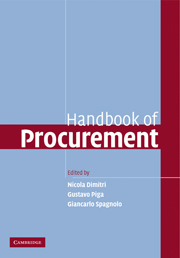Book contents
- Frontmatter
- Contents
- List of figures
- List of tables
- List of contributors
- Preface
- Part I Preliminary Issues
- Part II General Strategic Principles
- Part III Competitive Tendering Strategies
- Part IV Attracting and Screening Participants
- 10 Pricing and other business strategies for e-procurement platforms
- 11 Fostering participation
- 12 Scoring rules
- 13 Managing risky bids
- Part V Preventing Collusion and Corruption
- Part VI Dynamic Forces and Innovation
- Glossary
- Index
- References
13 - Managing risky bids
Published online by Cambridge University Press: 04 November 2009
- Frontmatter
- Contents
- List of figures
- List of tables
- List of contributors
- Preface
- Part I Preliminary Issues
- Part II General Strategic Principles
- Part III Competitive Tendering Strategies
- Part IV Attracting and Screening Participants
- 10 Pricing and other business strategies for e-procurement platforms
- 11 Fostering participation
- 12 Scoring rules
- 13 Managing risky bids
- Part V Preventing Collusion and Corruption
- Part VI Dynamic Forces and Innovation
- Glossary
- Index
- References
Summary
Introduction
Public procurement is plagued by bankruptcy. In the United States more than 80,000 contractors went bankrupt between 1990 and 1997, leaving unfinished private and public construction projects with liabilities exceeding US$ 21 billion. Bankruptcy is very costly for the buyer: the direct bankruptcy costs (e.g., administrative costs or lawyers) vary between 7.5 and 20 percent of the liquidation proceeds, and indirect costs (e.g., delays and other losses) are estimated to be even larger. Bankruptcy may arise when the payment (and therefore the winning bid) lies below the possible realized cost of the project. Why are suppliers willing to bid below the possible realized cost of the project? There are three main answers to this question: (i) the winning supplier underestimates the cost and bids too optimistically; this phenomenon is known as the ‘Winner's Curse’ and is studied in Chapter 6; (ii) the selected supplier expects to renegotiate the contract later on when it is very costly for the buyer to replace the incumbent contractor; this renegotiation generates cost overruns for the buyer and rents for the incumbent that are discounted in the bid and are discussed in Chapter 5; and (iii) aggressive bids might also be due to suppliers in a bad financial situation struggling for survival by taking a risky strategy. The possibility to file for bankruptcy implies that supplying firms have limited liability. If things go too badly, the supplier simply shuts down. Hence, the supplier's possible losses are bounded while its possible gains are not.
- Type
- Chapter
- Information
- Handbook of Procurement , pp. 322 - 344Publisher: Cambridge University PressPrint publication year: 2006
References
- 11
- Cited by



